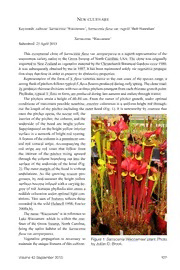Table Of ContentNew
cultivars
Keywords: cultivar: Sarracenia ‘Waccamaw’, Sarraceniaflava var. rugelii ‘Bob Hanrahan’
Sarracenia ‘Waccamaw’
Submitted: 25April 2013
This exceptional clone ofSarraceniaflava var. atropurpurea is a superb representative ofthe
uncommon variety native to the Green Swamp ofNorth Carolina, USA. The clone was originally
importedto NewZealandas vegetative material bythe ChristchurchBotanical Gardens circa 1980.
It was subsequently obtained by me in 1987. It has been maintained solely via vegetative propaga-
tion since that time in orderto preserve its distinctive properties.
Representative ofthe form ofS.flava varieties native to the east coast ofthe species range, a
strongflushofpitchers followstypicalS.flavaflowersproducedduringearlyspring.Thecloneread-
ilyproducesrhizomedivisionswithtwo orthreepitchersemergentfromeachrhizome growthpoint.
Phyllodia, typical S.flava in form, are produced during late autumn and endure throughwinter.
The pitchers attain a height of 60-80 cm. From the outset ofpitcher growth, under optimal
conditions ofmaximum possible sunshine, exterior coloration is a uniform bright red through-
out the length ofthe pitcher including the outer hood (Fig. 1). It is noteworthy by contrast that
once the pitcher opens, the nectar roll, the
interior ofthe pitcher, the column, and the
underside of the hood are bright yellow.
Superimposed on the bright yellow interior
surface is a network ofbright red veining.
A
feature ofthe columnis aprominent cen-
tral red vertical stripe. Accompanying the
red stripe are red veins that follow from
the interior of the pitcher rising upward
through the column branching out into the
surface of the underside of the hood (Fig.
2). The outermargin ofthe hood is without
undulations. As the growing season pro-
gresses, by mid-summer the bright yellow
surfaces become infusedwitha varying de-
gree ofred. Autumn phyllodia also attain a
reddish coloration under optimal light con-
ditions. This sum of features reflects those
recorded in the wild (Schnell 1998; Fowler
2008a,b).
The name ‘Waccamaw’ is in reference to
Fake Waccamaw which is within the con-
fines of the Green Swamp, North Carolina,
being the native habitat of the Sarracenia
flava var. atropurpurea.
Vegetative propagation is necessary to Figure 1 : Sarracenia ‘Waccamaw’ plant. Photo
maintainthe unique features ofthis cultivar. by Julian D. Brook.
Volume 42 September 2013 107
Figure 2: Sarracenia ‘Waccamaw’ front (left) and rear views (right). Photos by Julian D.
Brook.
References
Schnell, D. 1998. Sarraceniaflava L. varieties. Carniv. PI. Newslett. 27(4): 1 16-120.
Fowler, J. 2008a. Green Swamp Orchids and Carnivorous Plants, http://www.pbase.com/
jimfowler/2008051lgreenswamp, accessed 28April 2013.
Fowler, J. 2008b. Day trip to the Green Swamp, North Carolina, http://www.pbase.com/
jimfowler/20080504greenswamp, accessed28April 2013.
—
Don Gray •Auckland • New Zealand • [email protected]
Sarraceniajiava var. rugelii ‘Bob Hanrahan’
Submitted: 12 June 2013
In the early 1990’s, Peter received what looked like a typical Sarraceniaflava var. rugelii from
Bob Hanrahan. As it grew in the collection at California Carnivores, it became quite evident that
there was nothing typical about this plant. Damon remembers as a boy noticing it in the collection
andremarking to Peter about its striking beauty and size (Fig. 3).
It’s a nice tall clone, growingup to 80 cmtall. We have a fewS.flava's that grow a bittaller, but
none that are as elegant as this one. The tall pitchers are a yellow-green so bright that they seem
to glow in the vernal sunlight as they emerge. The only splash ofred is a solid patch in the throat,
typical ofthe rugeliivariety. Perfectly grownplants mayalso have athinredpicotee along the front
edge ofthe lid. The mouthofthepitcherflareswide like atrumpetandthe lip has adeep cleftinthe
front, which also adds to its regal appearance.
108 Carnivorous Plant Newsletter
Figure 3: Sarracenia fiava war. rugelii‘Bob Flanrahan’ pitchers and lid. The hand of young
CP grower David Green for scale.
Itis the ridiculouslyhuge lid, however, thatreallysets this clone apart. The large maturepitchers
haveanundulatinglidthatcanbejustover 15 cmacross! There’s achildlikejoyyougetfromputting
yourhandatopthepitchers andseeingitfitnicelyacrossthe gigantic lid(Fig. 3). Ithas a simple and
classic beauty reminiscent ofthe modern columns designed by Frank Lloyd Wright, which seem
too tall and top heavy to stand. Peter and Damon both agree that it is the most perfect S.fiava var.
rugelii that we have ever grown or seen. Itproduces only a fewpitchers per growthpoint, probably
due to the high energy costs ofproducingpitchers so large and spectacular. The flowers are typical
ofS.flava with long yellowpetals.
It is with much love and respect that we name this plant in honor ofour friend Bob Hanrahan.
He gave somuchto CaliforniaCarnivores inthe earlydaysandtothehobby ofgrowingcarnivorous
plants in general; we might not even be here today ifit weren’t for his generosity and enthusiasm
overthe years. Whenwe heard ofhis passing, we knewthatwe wouldhave to name one ofthevery
best plants in our collection for him. This seems a fitting choice, as it has long been one ofour all-
time favorite plants and its tall, statelypitchers remindus ofBob himself.
Previously, this plant has been labeled as Sarraceniafiava var. rugelii “Big Lid”, however, this
oldname shallno longerbe usedhereafter.
We are intheprocess ofestablishingthis clone into tissue culture, so thateveryone mayhave the
pleasure ofgrowing this wonderful plant. True Sarracenia ‘Bob Hanrahan’ should only be vegeta-
tivelypropagated. Seeds obtained by selfing or out-crossingwillprobablynotbe true.
—
DamonCollingsworth • PeterD’Amato • CaliforniaCarnivores *2833 OldGravensteinHwy
• Sebastopol, CA 95472 • [email protected]
Volume 42 September 2013 109

